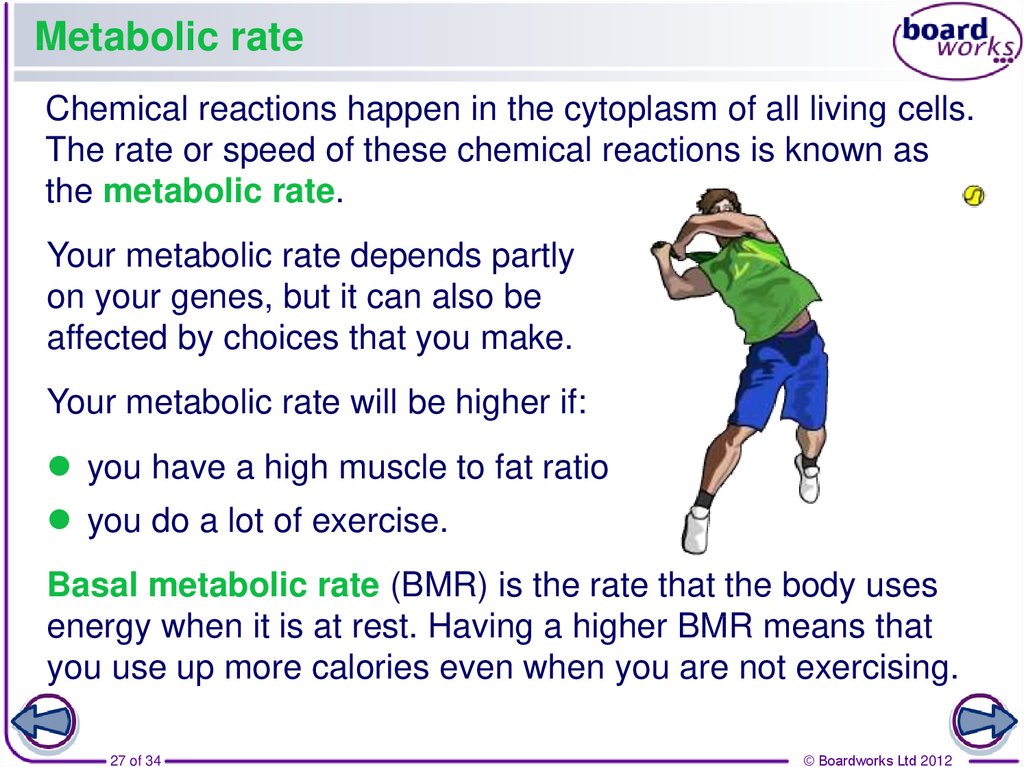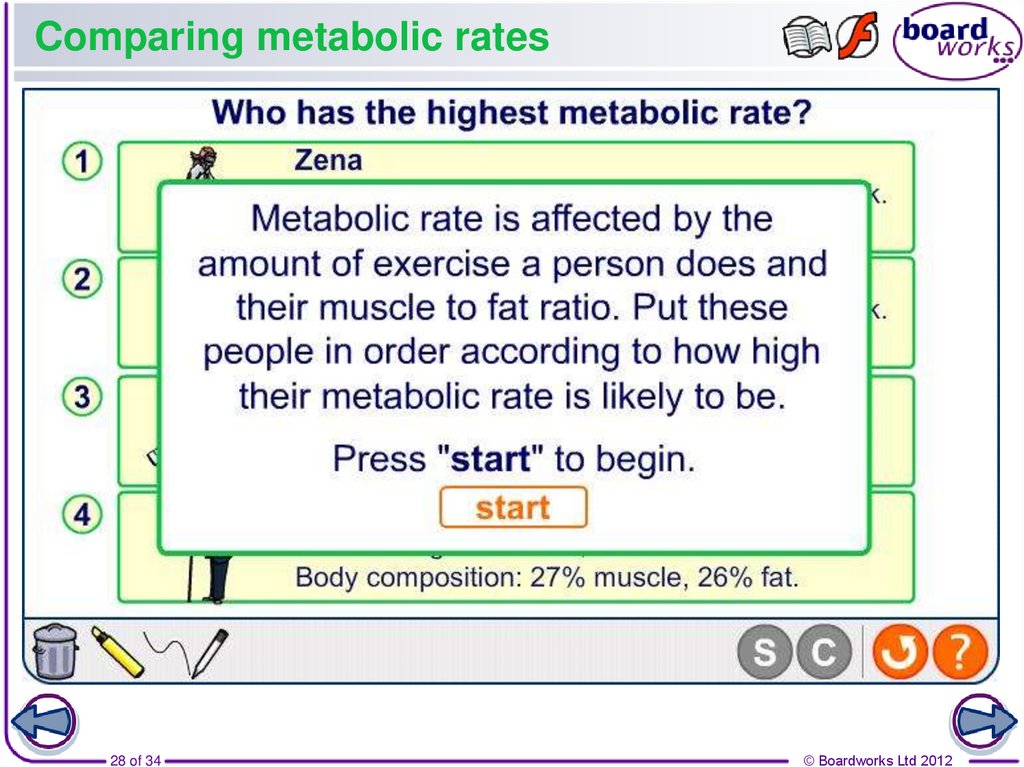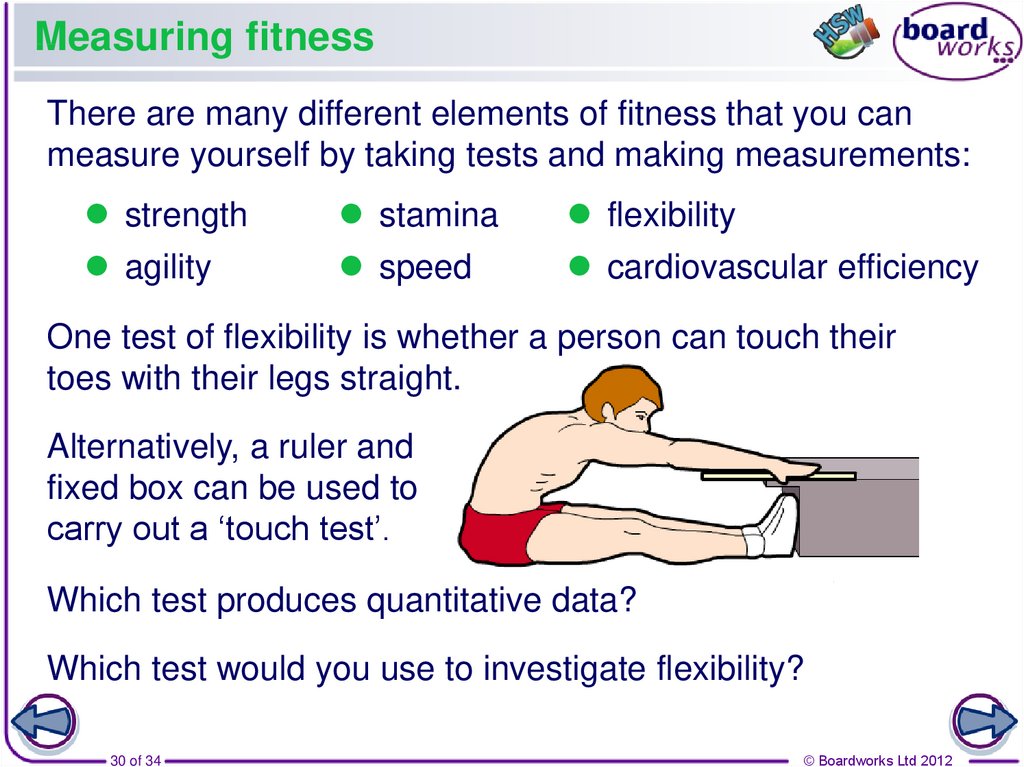Similar presentations:
Diet exercise and health
1. Diet, Exercise and Health
1 of 34© Boardworks Ltd 2012
2.
2 of 34© Boardworks Ltd 2012
3. Healthy diet
A healthy diet should have the right balance ofdifferent foods and give the right amount of energy.
As well as carbohydrates, fats and proteins, a
balanced diet should include:
minerals – elements that are needed
by our bodies in small amounts
vitamins – chemicals that help our
bodies perform various processes
fibre – indigestible parts of our food
needed to make the gut work properly
water – needed for cell chemistry.
3 of 34
© Boardworks Ltd 2012
4. Vitamins and minerals in the body
4 of 34© Boardworks Ltd 2012
5. What are vitamins and minerals for?
5 of 34© Boardworks Ltd 2012
6. What is a deficiency disease?
A person who does not eat a balanced diet, or does noteat enough food, is said to be malnourished.
Vitamins and minerals cannot be
made by the body. So, when they are
absent from a diet, a person may
suffer from a deficiency disease.
Each deficiency disease has
characteristic symptoms. Nutritionists, dieticians and doctors
need to be able to recognize these symptoms in order to
diagnose the disease and cure the patient.
Deficiency diseases can be cured by eating the right food.
6 of 34
© Boardworks Ltd 2012
7. Diagnosing deficiencies
7 of 34© Boardworks Ltd 2012
8.
8 of 34© Boardworks Ltd 2012
9. Personal choice
Some people restrict their diets by choice. This may be forethical or religious reasons, or perhaps just because they
don’t like something.
Vegetarian diets do not contain
meat. People often become
vegetarian if they believe it is
wrong to kill animals for food.
Vegan diets do not have any animal
products in them. This includes eggs
and dairy products as well as meat.
By limiting your diet, you can become malnourished.
People on special diets must balance what they eat to
make sure they are not deficient in any vital nutrients.
9 of 34
© Boardworks Ltd 2012
10. Diet and religion
Some people limit their diet because of their religious beliefs.Here are some examples:
Muslims only eat ‘halal’ meat which
has been killed in a special way.
Jewish people follow a kosher diet,
where certain foods, like pork, are
forbidden. Some foods cannot be
eaten together, for example, meat
and cheese.
Buddhists believe in non-violence,
so they follow a vegetarian diet that
does not involve killing animals.
10 of 34
© Boardworks Ltd 2012
11. Food allergies and food intolerances
Food allergies are caused by the body’s immune systemconfusing safe food for something dangerous.
Common foods that cause allergies include eggs and nuts.
Most food allergies are mild and may
only cause a slight rash. Occasionally
they can be life threatening. In severe
attacks a person may go into
anaphylactic shock. This can be
treated with an adrenaline injection.
Food intolerances do not involve the immune system.
The symptoms of a food intolerance could include a
stomach ache, wind or a change in toilet habits.
11 of 34
© Boardworks Ltd 2012
12. Allergies, intolerances and diet
People with food allergies and intolerances have tolook closely at the packaging of the food they buy.
Common allergens
are often identified
on food packaging.
People with food intolerances and allergies
have to restrict their diet. For example,
being lactose intolerance means that one
cannot consume cows’ milk. This can lead
to calcium deficiency and health problems.
12 of 34
© Boardworks Ltd 2012
13. Why do people alter their diets?
13 of 34© Boardworks Ltd 2012
14. Quantitative or qualitative?
14 of 34© Boardworks Ltd 2012
15.
15 of 34© Boardworks Ltd 2012
16. Energy requirements
16 of 34© Boardworks Ltd 2012
17. Body mass
Body mass is the mass of a person measured in kilograms.As you grow, your body mass increases.
Women tend to have a lower body mass than men.
If people eat too much energy,
body mass increases and they
become overweight.
If people eat too little energy
their body mass may
decrease and they can
become underweight.
To maintain your body mass, you need to balance the
energy you eat against the energy you use. The energy
your body needs changes depending on physical activity.
17 of 34
© Boardworks Ltd 2012
18. How much energy do you need?
18 of 34© Boardworks Ltd 2012
19. Unhealthy diets?
19 of 34© Boardworks Ltd 2012
20. The problem with fast food
This table shows typical calorie contents for some typesof takeaway fast food.
food
typical calories
burger
500–650
¼ pizza
400–700
kebab
900–1000
curry
800–1000
Why might eating fast food make
maintaining your body mass difficult?
As well as a lot of calories, fast food often also contains
high levels of salt and saturated fats.
20 of 34
© Boardworks Ltd 2012
21. What is BMI?
Body Mass Index (BMI)measures the relative amounts
of fat and muscle in the body.
BMI = body mass (kg)
(height)2 (m)
Gloria: 1.45 m and 66 kg
BMI = 31
BMI
Conclusion
<20
underweight
Zak:
20-25
normal
25-30
overweight
>30
obese
1.85 m and 66 kg
BMI = 19
What are their health risks?
Obese people have an increased risk of arthritis, diabetes
and heart disease. People who are underweight tend to
have poor immune systems and often get ill.
21 of 34
© Boardworks Ltd 2012
22. BMI calculations
22 of 34© Boardworks Ltd 2012
23. Are you right for your height?
In 2008, 21% of boys and 18% of girls aged 11–15 in the UKwere obese. Statistics show that obesity levels, among both
young people and adults, have risen over the last ten years.
Calculating a person’s BMI
can be useful, but the
formula can overestimate the
proportion of body fat in
people who are muscular.
This is because muscle
is more dense than fat.
This means it is helpful to use extra measures to help judge
how healthy a person is, such as waist circumference.
23 of 34
© Boardworks Ltd 2012
24. What is diabetes?
People with diabetes are unable to regulate their bloodglucose levels because their bodies don’t produce enough of
the hormone, insulin, or because their cells don’t respond to it.
Type II diabetes can be caused by obesity.
Blood glucose levels in diabetics can
rise dangerously high after eating,
which can cause cell damage.
Symptoms of diabetes can be
severe. Initial symptoms include:
increased thirst, hunger
and production of urine
weight loss, tiredness
and nausea.
24 of 34
© Boardworks Ltd 2012
25. Obesity and diabetes
25 of 34© Boardworks Ltd 2012
26.
26 of 34© Boardworks Ltd 2012
27. Metabolic rate
Chemical reactions happen in the cytoplasm of all living cells.The rate or speed of these chemical reactions is known as
the metabolic rate.
Your metabolic rate depends partly
on your genes, but it can also be
affected by choices that you make.
Your metabolic rate will be higher if:
you have a high muscle to fat ratio
you do a lot of exercise.
Basal metabolic rate (BMR) is the rate that the body uses
energy when it is at rest. Having a higher BMR means that
you use up more calories even when you are not exercising.
27 of 34
© Boardworks Ltd 2012
28. Comparing metabolic rates
28 of 34© Boardworks Ltd 2012
29. Health and fitness
Health and physical fitness are different.A healthy person is free from disease or abnormality.
A fit person has good cardiorespiratory, aerobic and
muscular endurance.
Physical fitness has many
advantages. Exercise reduces your
risk of heart disease and other
illnesses, helps keep your body
mass down and can even improve
your mood and self-esteem.
How can fitness be measured?
How many methods can you think of?
29 of 34
© Boardworks Ltd 2012
30. Measuring fitness
There are many different elements of fitness that you canmeasure yourself by taking tests and making measurements:
strength
stamina
flexibility
agility
speed
cardiovascular efficiency
One test of flexibility is whether a person can touch their
toes with their legs straight.
Alternatively, a ruler and
fixed box can be used to
carry out a ‘touch test’.
Which test produces quantitative data?
Which test would you use to investigate flexibility?
30 of 34
© Boardworks Ltd 2012
31.
31 of 34© Boardworks Ltd 2012
32. Glossary
32 of 34© Boardworks Ltd 2012
33. Anagrams
33 of 34© Boardworks Ltd 2012
34. Multiple-choice quiz
34 of 34© Boardworks Ltd 2012


































 english
english life safety
life safety








